 |
| River Valley Photo by Afraimstichter from https://pixabay.com/photos/flow-river-meander-river-bend-3982207/ |
This world history resource focuses on early river valley civilizations living between 3500 B.C. and 450 B.C. and includes quiz questions and answers and video links to related topics.
I utilized World History: Patterns of Interaction (Holt McDougal) for our world history textbook.
It has multiple options for different learning styles and covers a wide array of information.
I designed the following quiz with questions and answers to accompany Chapter 2: pages 26-57.
Directions for the quiz:
- Scroll down and click on the thumbnail to enlarge to full screen.
- Click on the graphic to advance to the next screen.
- Choose an answer for each question.
- Compare your answers with those provided.
log in to Kahoot! and search for Week 2 World History by Katrena.
National Geographic: Ancient Mesopotamia
National Geographic: Ancient Egypt 101
Virtual Egypt 4K: What did the pyramids look like
How the Rosetta Stone Unlocked Hieroglyphics
Crash Course: Indus Valley Civilization
Ancient Wonder in China Transforms a River
How Chinese Characters Evolved
Crash Course: Mandate of Heaven
Thanks for visiting my StudentSurvive2Thrive blog.
Feel free to search for resources via the site map,
topics on the right or my search bar to see more articles.
Below are a few of my articles you may find helpful this week:
- Week 2 Visual Arts: Graffiti Art
- Week 2 Ninth Grade ELA Assignments
- How to Communicate with an Online Teacher - Tips from a Professor
 |
| World History Week 2: Early River Valley Civilizations 3500 B.C. to 450 B.C. |
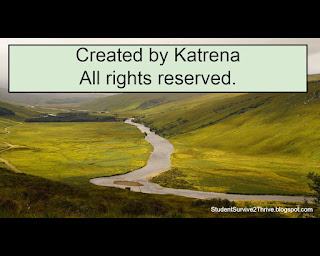 |
| Created by Katrena. All rights reserved. |
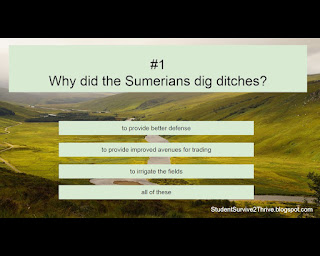 |
| Why did Sumerians dig ditches? Answer choices include: to provide better defense, to provide improved avenues for trading, to irrigate the fields, all of these |
 |
| The correct answer is to irrigate the fields |
 |
| Priests were responsible for leading their cities into war around 3000 B.C. Answer choices are: true, false |
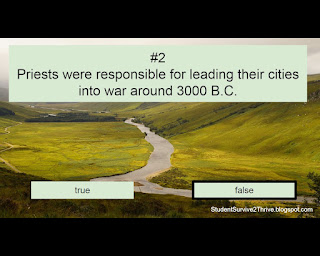 |
| The correct answer is false. |
 |
| The correct answer is dynasty. |
 |
| ____ is the belief in more than several gods. Answer choices include: monotheism, polytheism, demonism, dualism |
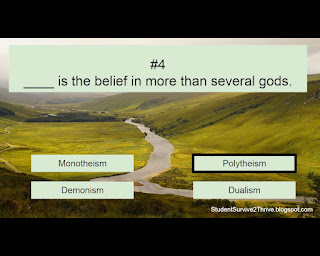 |
| The correct answer is polytheism. |
 |
| Sumerian women had more legal rights than women in many civilizations of later times. Answer choices include: true, false |
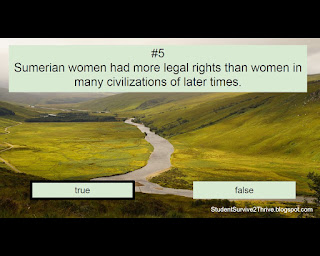 |
| The correct answer is true. |
 |
| The correct answer is consultation of the gods through oracle bones. |
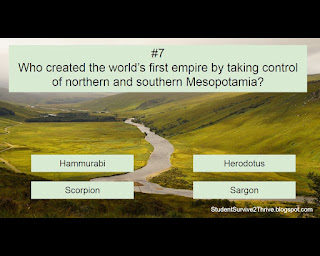 |
| Who created the world’s first empire by taking control of northern and southern Mesopotamia? Answer choices include: Hammurabi, Herodotus, Scorpion, Sargon |
 |
| The correct answer is Sargon. |
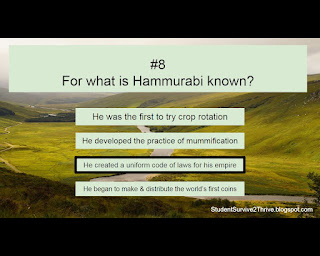 |
| The correct answer is He created a uniform code of laws for his empire. |
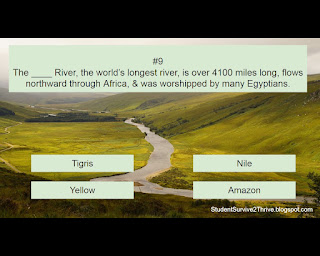 |
| The ____ River, the world’s longest river, is over 4100 miles long, flows northward through Africa, & was worshipped by many Egyptians. Answer choices include: Tigris, Nile, Yellow, Amazon |
 |
| The correct answer is Nile. |
 |
| Around 3000 B.C., Egyptians believed their kings, called ____, were gods and were responsible for the kingdom’s well-being. Answer choices include: pharaohs, prime ministers, admirals, presidents |
 |
| The correct answer is pharaohs. |
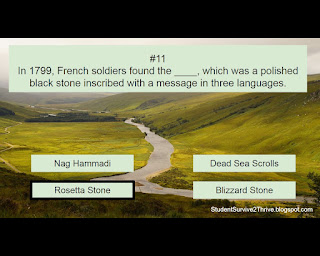 |
| The correct answer is Rosetta Stone. |
 |
| Egyptians invented a writing surface using ____ that was a precursor to our paper today. Answer choices include: slate, papyrus, mica, silt |
 |
| The correct answer is papyrus. |
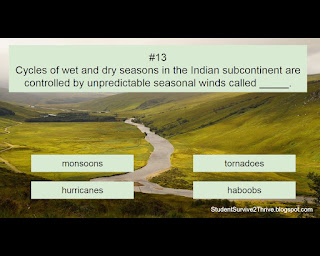 |
| Cycles of wet and dry seasons in the Indian subcontinent are controlled by unpredictable seasonal winds called _____. Answer choices include: monsoons, tornadoes, hurricanes, haboobs |
 |
| The correct answer is monsoons. |
 |
| Indus cities built around 2500 B.C. were laid out in an erratic fashion. Answer choices include: true, false |
 |
| The correct answer is false. |
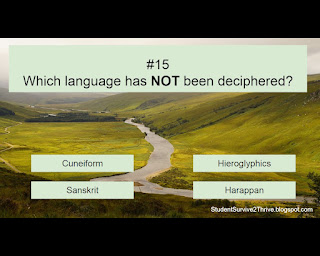 |
| Which language has NOT been deciphered? Answer choices include: Cuneiform, Hieroglyphics, Sanskrit, Harappan |
 |
| The correct answer is Harappan. |
 |
| The correct answer is all of these. |
 |
| China’s Huang He (Yellow River) deposits silt that is fertile soil with a yellow hue known as _____. Answer choices include: loam, loess, chalk, peat |
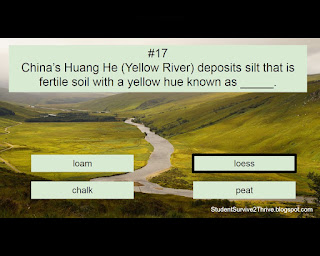 |
| The correct answer is loess. |
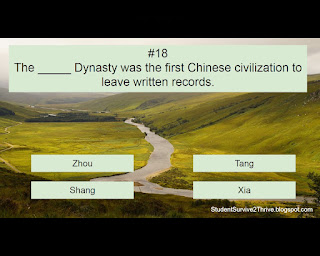 |
| The _____ Dynasty was the first Chinese civilization to leave written records. Answer choices include: Zhou, Tang, Shang, Xia |
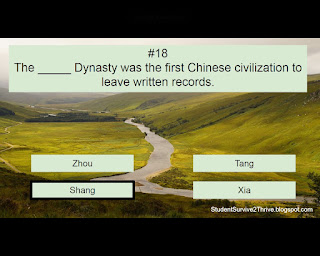 |
| The correct answer is Shang. |
 |
| The correct answer is respect for one's family. |
 |
| The correct answer is Feudalism. |
 |
| Find more resources at StudentSurvive2Thrive.blogspot.com |
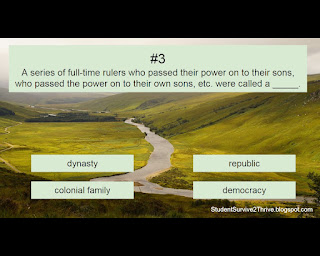




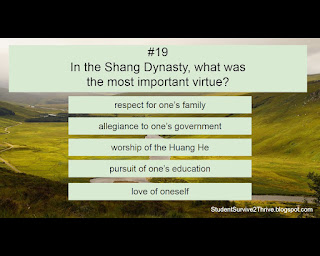
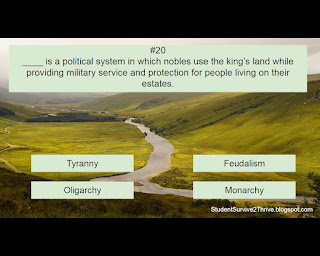
No comments:
Post a Comment
Thanks for reading my article and sending your comment! Please note that I do not place links to other web sites on this blog.
Note: Only a member of this blog may post a comment.